by Sarah Mowry
With summer comes the arrival of peak wildflower season in Central Oregon! Warmer weather moves the spring blooms that brighten our sagebrush meadows to the forests and meadows of the high Cascades. One of the most showy (and dare I say beloved) wildflower families is the lily, or Liliaceae, family. As you are out and about this summer, watch for these native lilies to celebrate the season.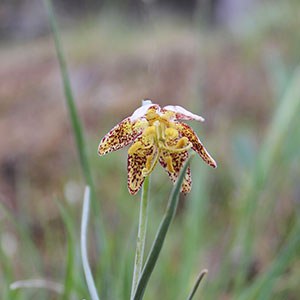
Other common names: spotted mountain bells
Perhaps one of our most unusual lilies, the spotted fritillary is brown to greenish in color with yellow, red, or white markings. They grow in grasslands or Cascade foothill forests and can be hard to spot because of their subdued color. But just because they are subdued, doesn’t mean they aren’t stunning! The beautiful spotting and delicate petals just beg for a closer look. Flowers hang downward or facing outward and 1-3 blooms can be found per stalk.
Bloom time: late spring-early summer
Spot them at this Land Trust Preserve: Camp Polk Meadow Preserve, Metolius Preserve, Metolius River Preserve, Whychus Canyon Preserve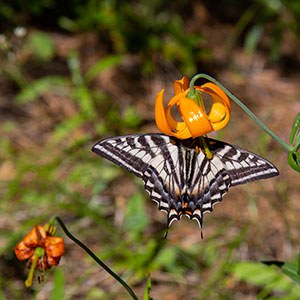
Other common names: tiger lily, Oregon lily
The curvy bright orange petals of this lily call to you from afar. Columbia lilies have numerous six-petal blooms on a tall stems. Found in the wetter parts of Central Oregon, you can find these along the banks of our local rivers and in nearby mixed-evergreen forest. The fiery orange petals of the Columbia lily curve upward creating a ball of orange with tiny dark spots. Perhaps this is why they are affectionately called tiger lily—can’t you just see the tiger curled and ready to pounce? The edible bulbs of the Columbia lily are prized by Native Americans.
Bloom time: early summer
Spot them at this Land Trust Preserve: Metolius River Preserve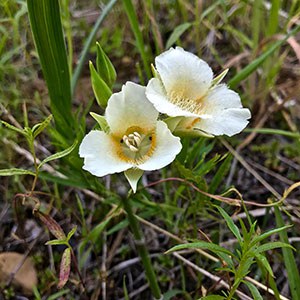
Other common names: mountain cat’s ear, Cascade mariposa lily
This three-petal stunner is also a favorite in our east Cascade foothill forests. Multiple blooms can be found on an ~8 in tall stem. Flowers are often a creamy white to yellow, but their true beauty is only seen under close examination. Delicate hairs abound on and around the petals of the flower bringing to mind the ear of a cat.
Bloom time: mid summer
Spot them at this Land Trust Preserve: Metolius Preserve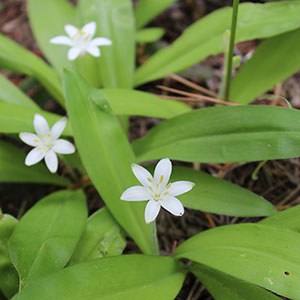
Other common names: bead lily, blue bead, bride’s bonnet
This lily’s common name aptly describes its stately, bright white bloom. Low growing (2-6 in tall) with 2-3 large leaves at its base, queen’s cup lilies are common in forests on the slopes of the east Cascades. You can often find them growing in clumps that form a ground cover on the forest floor. Once its bloom fades, you can still find this lily by its brilliant blue bead-like seed.
Bloom time: mid summer
Spot them at this Land Trust Preserve: Metolius Preserve, Metolius River Preserve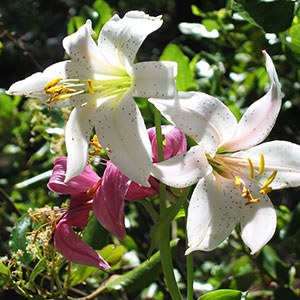
Other common names: Washington lily
This may be the true queen of the lilies! Large, opulent flowers on 2-8 ft tall stalks bring to mind traditional lilies that are sold in flower shops. Each plant boasts several white to pinkish flowers with as many as 25 blooms per plant. Leaves are in regular whorls moving up the stem. Can be found in east Cascade foothill forests lighting up an otherwise brown and green landscape.
Bloom time: mid summer
Spot them at this Land Trust Preserve: Metolius Preserve, Metolius River Preserve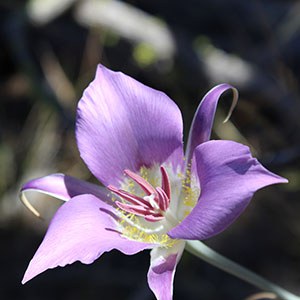
Other common names: green-banded lily
This is one of the showy lilies that bucks the trend! Instead of retreating to the cooler forested foothills, the mariposa lily loves the sagebrush desert and blooms at a time of year when many other flowers have finished. Large purple to pink flowers on 8-23 in tall stems. Like their cousin, the subalpine mariposa lily, these lilies are best appreciated up close where you can see their lovely yellow and pink-banded throat.
Bloom time: mid summer
Spot them at this Land Trust Preserve: Whychus Canyon Preserve
Learn more:
- Join the Land Trust for a guided walk or hike and see what's blooming!
- Learn more about the wildflowers of Whychus Canyon Preserve.


